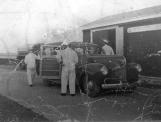1
A third airline to establish a base of operations in the Bay of Exploits was American Export Airlines. While not as impressive as the Pan Am or BOAC operations, they nonetheless played a significant role in the area's development. American Export flew three flights weekly, originating in New York and finally arriving in Southampton, England, stopping in Foynes, Ireland and Botwood, Newfoundland for fuel.American Export Airlines had an extremely strong service during the war years but it was after the war when the company began to stand out. A merger with American Airlines established American Overseas Airlines (AOA). AOA later merged with Pan American Airways.
There were at least two flying boat crashes in the Botwood harbour. One took place on Saturday, October 3, 1942. The Excalibur, a 27 ton American Export flying boat with 26 passengers and a crew of 11, was taking off to fly to another airport in Newfoundland with a partial load of fuel. At 7pm the plane taxied into the stream, followed by an Air Force crash boat. The plane suddenly went into a bouncing action known in aviation circles as a "porpoise take-off." It went about 30 feet in the air and suddenly crashed in the water. It is believed that the back of the plane was broken.
Eleven persons were killed and four were missing; the bodies of the latter are believed to still be in the sunken plane. Seven bodies were recovered from the plane. Five passengers and three of the crew were taken to hospital; some badly injured. Mr. W. T. Myers died while he was being taken ashore; Mr. Dwight Thomas died in the hospital shortly after arrival; Colonel Bradley died in hospital on Sunday night; and Mr. L. Galantier, a New York banker, had to stay in hospital. The hostess of the flying boat and another female passenger were saved.
Mr. Thomas Power of Grand Falls, an experienced diver, was called to Botwood that night. Mr. Power succeeded in getting out four of the bodies of trapped passengers. The sunken plane was raised for a short period, but later it sank back out of sight in about seven fathoms of water after attempts to tow it to shore failed. Officials of the airlines arrived to conduct an investigation.
Garland Peyton of Botwood was working on the base during the war. He remembers seeing the incident while standing near his home. He recalls that the plane appeared to have hit an air pocket and to stall in mid-air.
It was high enough up that you could see the shadow on the water, and when it came down it made a spray. The backflow of water from the wave that was created must have caught the blades of the propellers and it made a loud roar. The tail of the plane broke off and stayed above water as the rest of the aircraft became submersed (Inder, 1988).
Peyton also reported that an effort was made to tow the plane over to a ramp by the boathouse, but as the insulation in the plane soaked, it became very heavy and the aircraft sank out of sight.
A former resident of Botwood, Levi Skinner, was in charge of planes landing and taking off from the harbour. He didn't see the crash take place but he authorized men to recover survivors and bodies from the crash.
I shot the boat up alongside the aircraft near the tail section that was afloat. I could see a man's hand sticking out about three feet under water so I reached down and got hold of his hand and squeezed it to see if there was any life in it. There was no sign of life. I pulled on the hand to try and get the body aboard the boat, but the body was stuck in the fold of the plane where it had cracked off. I realized that if I just left the dead body there it would probably be swept away by the current, so I tied a piece of rope around the wrist and secured it to the plane's fuselage (Inder, 1988).
About two or three weeks later, a Canadian navy ship attempted to raise the plane out of the water with a crane. Skinner said that as the tail section was raised, the body of the man he tied on was swinging in the air by his wrist.
When Skinner first tried to get the corpse out of the wreckage, he said a United States Army ring slid off the dead man's finger into his hand. "I just slipped it into my pocket at the time because I figured that if I gave it to someone else, it would never be seen again" (Inder, 1988). A name engraved on the back of it was that of a Colonel Whitaker.
About three years later Skinner was sent to New York to work with Imperial Oil. While there, he contacted American Export Airlines Limited and got the address of the family of the man who was killed and whose ring he had. It was eventually returned to the family and a letter of appreciation was sent to Skinner from Whitaker's relatives.






